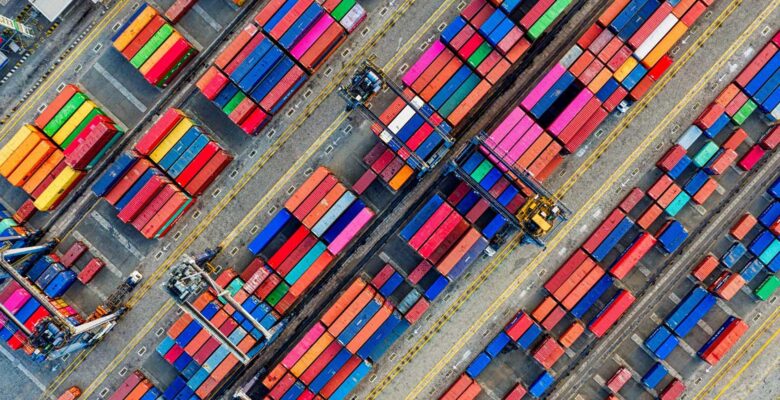
The pandemic’s impact on the global supply chain
From empty shelves upsetting shoppers and parts shortages interrupting manufacturers, to shipping delays and soaring costs, the pandemic has shone a spotlight on the global supply chain and the challenges in keeping goods moving efficiently along it.
The pandemic has created new challenges for supply chains, putting them under the utmost pressure and bringing to light previously unseen vulnerabilities.
Exacerbated by staff shortages, due to COVID-19, the ability of ports to work at full capacity has been undermined and the pandemic has accelerated and magnified problems that already existed in the supply chain, such as the pay and working conditions of critical workers, like HGV drivers.
Freight costs on the busiest and most important routes have soared because of disruption, the grounded passenger aircraft fleet removing >50% of air freight capacity and a massive reduction in sea freight capacity, due to containers and the vessels that carry them, being out of position.
The hope remains strong that these cost pressures will dissipate over time, as spending shifts from consumer products back to services and while freight rates are likely to remain higher than before the crisis, they are unlikely to stay at their current levels.
2020 – The COVID outbreak’s supply chain impact
- 1st quarter Coronavirus lockdown in China, prompts carriers to withdraw vessels.
- Global lockdowns ensue, with carriers cutting further capacity of vessels and grounding of global passenger aircraft fleet.
- Massive demand returns mid-year as consumers turn from services to products.
- Shipping lines begin to return vessels, which are now vastly off schedule.
- Airlines introduce passenger freighters (Preighters) to carry cargo only, predominantly for the PPE spike.
- Ocean capacity constrained and shipping lines begin to cancel longer term contracts and start to push shippers and importers to the FAK (Freight All Kind) spot market.
- Ocean and air freight rates escalate to their first quarter levels by up to 1000%.
- Vessel schedules became even less reliable, causing congestion at ports, with shipping containers in much longer transits and not retuned to the areas of manufacture creating further delays.
2021 – Where we are now
- Freight rates remain firm, despite some expectation of them softening post-Chinese New Year and into early Q4.
- Airlines remained busy, without passenger support, and rate levels for air cargo increased significantly as the sole source of income.
- Lockdowns affect manufacturing and lead times, with infrastructure congested.
- Extended ocean transits and shortage of equipment effectively cuts capacity by 25%.
- Reliability of carriers is totally lost with just 30% vessels on schedule.
- Global port congestion disrupts arrivals/departures and return of empty containers.
- Inland haulage and multimodal services (road transport with rail) in UK, Europe, North America become congested .
- Insufficient HGV drivers creating additional issues at destination and further congestion resulting in storage, detention and demurrage additional costs.
- Airlines still operating predominantly on cargo only basis with freight being the only income and pricing at record levels entering peak season.
- Freight rates on all modes remain historically high, resulting in a ‘pay to play’ environment, with carriers focused on most profitable lanes and markets.
- Power supply outages in China, creating pressure on manufacturing of products.
2022 – Looking to the future
- As passenger travels opens up globally we would expect pricing to soften, as carriers see passenger income return and belly-hold space adds to market capacity.
- Many carriers are very bullish about 2022 and will not currently offer any form of pricing for 2022 contracts which will unwind over the final quarter.
- There are very few new build vessels entering service over the next 15 months to the end of 2022, so capacity is likely to remain restricted.
- Inflation could impact consumer demand, reducing pressure on global logistics and all stages of the supply chain, including product manufacturing.
- Carriers will continue pushing for longer term contracts of 2 years and either not offer 12 month contracts or point customers to the FAK/Spot market.
- Confident shipping lines, eager to continue growing the ‘bottom line’ and airlines keen to recoup losses will maximise revenues from cargo movements.
In summary
The pandemic supply chain challenges that have driven up prices for consumers and slowed the global economic recovery, will lessen in time. But recovery remain tenuous and easily set back by unseen events and weak links, like the shortage of HGV derivers in the UK and China’s drive for zero COVID cases.
By 2023 (and possibly late 2022) the COVID19 situation should be under control and consumer demand settled, providing stability in global shipping.
The capacity of the global container fleet will have grown by 20%, as new vessels are delivered and schedule reliability will have returned, though there is a question mark over how much tonnage the the 9 major shipping lines (in 3 alliances) may withdraw or retire from the market, to manipulate capacity.
Political and global events that cannot be considered or are transparent currently, may yet have a huge influence on global supply chains, on all modes and in all regions of the world.
Local issues are now intertwined with global occurrences due to the fragile state of ocean freight and air markets and have demonstrated how unpredictable the movement of your goods has become.
The shipping lines are expected to declare in excess of $150 BILLION pre-tax profits in the current financial year and it is unlikely they will want to give that up, considering what they have experienced and learned over the last 18 months on market dynamics and influences. They are in control of events and their success.
